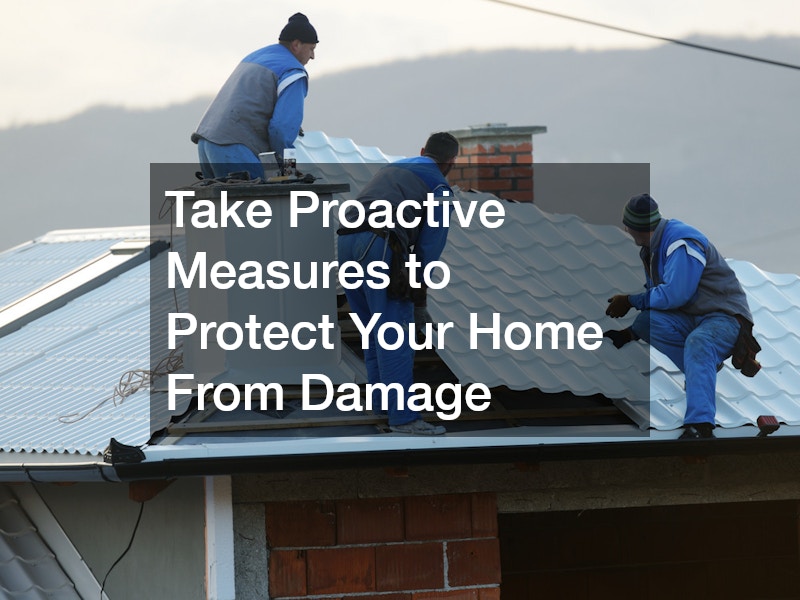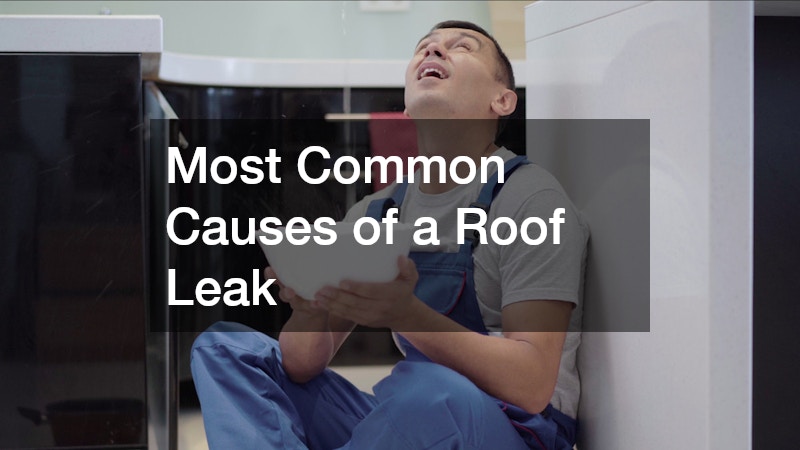Understanding the root causes of roof leaks is essential for homeowners looking to maintain a safe and dry living environment. Let’s explore the most common reasons for roof leaks, providing insights and solutions to prevent them with the help of roofing contractors
What Are the Most Common Signs of a Roof Leak?
Visible Water Stains
Water stains are often the first indication of a roof leak, appearing as discolored patches on ceilings or walls. These stains indicate that water has penetrated the roofing layers and reached the interior surfaces.
The presence of water stains suggests potential damage not only to the roof structure but also to the underlying building materials. If left unchecked, this can lead to structural weakening and more costly repairs.
Observing the spread and intensity of water stains can help determine the severity and origin of the roof leak. Early detection through visible signs is key to preventing extensive damage.
Peeling Paint or Wallpaper
Peeling paint or wallpaper is another common sign of moisture getting through the roof. As water infiltrates the building, it affects the adhesion of paint or wallpaper to surfaces.
This occurrence is not only a cosmetic issue but also a signal of greater undercurrents of water damage within the structure. Over time, prolonged exposure to moisture can cause significant harm to the building’s integrity.
Addressing the root cause of peeling paint is crucial in mitigating further deterioration. Repairing the leak and addressing any mold or mildew will help preserve the building’s aesthetic and structural soundness.
Why Do Shingles Become Damaged?
Weather-Related Wear and Tear
Roof shingles are consistently exposed to various weather conditions, including rain, wind, and UV radiation. Over time, these elements contribute to the gradual degeneration of shingle materials.
In regions with extreme weather variations, such as heavy snowfall or intense summer heat, the wear and tear on shingles can be even more pronounced. These environmental stresses can lead to cracks, curling, or complete shingle loss.
Factoring in local climatic conditions when selecting and maintaining roofing materials can extend the longevity of your shingles. Regular inspection and timely repair can dramatically reduce weather-related damages.
Poor Installation Practices
Substandard installation is a significant factor in premature shingle damage. Incorrect nailing techniques, improper fastening of shingles, and insufficient underlayment can compromise the entire roofing system.
Poor installation practices often become evident during severe weather events when the inadequacies are put to test. Loose or poorly aligned shingles may give way, leading to leaks and other related issues.
Hiring experienced and reputable roofing contractors is essential to ensure proper installation. A professionally installed roof can withstand environmental challenges more effectively.
How Can Clogged Gutters Lead to Roof Leaks?
Water Overflow Issues
Clogged gutters pose a serious threat by obstructing water flow away from the roof. When gutters are blocked, rainwater can overfill and spill over the edges, potentially seeping into the roof and causing leaks.
This overflow can lead to water pooling near the roofline, increasing the risk of leakage and damage to both the roof and walls. Regular maintenance of gutter systems is crucial to avoid these overflow issues.
Ensuring gutters are free of debris and functional can prevent water from reaching undesirable areas. Simple preventative measures can safeguard your home from potential leaks and water damage.
Ice Dams Formation
In colder climates, ice dams can form when clogged gutters prevent water from draining properly. Ice dams occur when melting snow refreezes at the edge of the roof, causing water to back up under the shingles.
This trapped water can eventually seep through the roof, leading to leaks and significant damage during winter months. Ice dams not only damage roofs but can also compromise attic insulation and lead to mold growth.
Attending to gutter maintenance and ensuring proper attic insulation can mitigate the risk of ice dams. Such measures are essential for maintaining the integrity of roofs in regions prone to heavy snowfall.
What Role Does Attic Ventilation Play in Preventing Leaks?
Moisture Control
Proper attic ventilation plays a critical role in controlling moisture levels within the roof structure. Without adequate ventilation, condensation can accumulate, leading to potential leaks and mold growth.
Moisture can lead to wood rot and deterioration of roofing materials, ultimately reducing the lifespan of the roof. Effective ventilation systems help manage humidity and maintain a balanced indoor climate.
Installing vents and ensuring good airflow can prevent moisture buildup and safeguard the structural components of the roof. Regular checks on ventilation systems are recommended for homeowners.
Extending Roof Lifespan
Beyond preventing leaks, proper attic ventilation contributes significantly to extending the lifespan of the roof. By reducing excess heat and moisture, roofs are less susceptible to damage and premature aging.
This environmental regulation helps maintain the integrity of roofing materials over time. A well-ventilated attic is an investment that offers long-term protection and value for homeowners.
Attention to attic ventilation can prevent costly repairs and increase your roof’s durability. Proactive measures in ventilation management are key to avoiding unnecessary roofing expenses.
Roof leaks can be caused by various factors, from external weather conditions to internal ventilation issues. By recognizing the signs and understanding the underlying causes, homeowners can take proactive measures to protect their homes from water damage.

